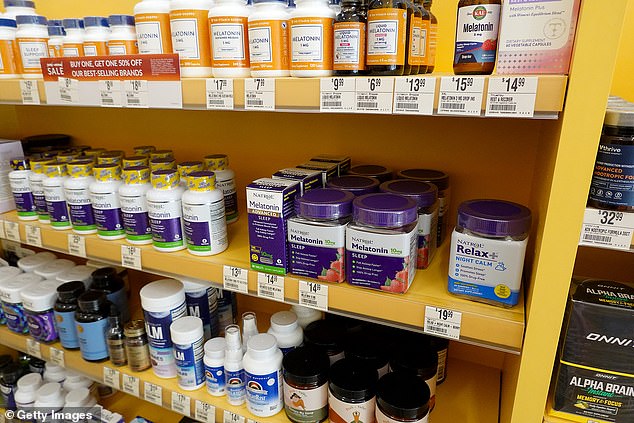Experts ‘sound the alarm’ after finding a fifth of children in the US now take melatonin for sleep – despite growing concern about health risks
Nearly 20 percent of five to 13-year-olds use the sleep aid melatonin, an increase from just one percent six years ago, prompting scientists to ‘sound the alarm’ about its increasing use.
Researchers from the University of Colorado Boulder analyzed data from 993 children aged one to thirteen years old and found that use of the hormone increased significantly with age.
In total, in the past 30 days, about 39 percent of the children in the story had consumed melatonin, a hormone naturally produced in the body that plays a role in sleep.
The prevalence of melatonin consumption was highest among 10- to 13-year-olds, with parents reporting that 19.4 percent had used melatonin. The prevalence was second highest in children aged five to nine, with parents reporting that 18.5 percent had used the sleep aid in the previous 30 days.
Lead author Dr. Lauren Hartstein, a fellow in the Sleep and Development Lab at CU Boulder, said, “We hope this article raises awareness among parents and physicians, and sounds the alarm to the scientific community.
‘We are not saying that melatonin is necessarily harmful to children. But much more research needs to be done before we can say with confidence that it is safe for children to use long-term.’
The graph above shows the use of melatonin in children aged one to thirteen years old over the past 30 days

In the US, melatonin supplements are available over the counter as a dietary supplement – including in kid-friendly gummies – without a prescription
The smallest share of parents reporting consumption was that of children aged one to four years old: 5.6 percent.
The UC Boulder team reported that in a 2017-2018 survey, only 1.3 percent of American parents reported that their child(ren) had used melatonin in the past 30 days.
Sales of the supplement doubled in the US between 2017 and 2020.
The brain produces melatonin in response to darkness and helps regulate the body’s internal clock, signaling the body that it is time to sleep
In many countries, the hormone is classified as a drug and is only available with a prescription from a doctor.
However, in the US, melatonin supplements are available without a prescription as a dietary supplement – including in kid-friendly gummies – and can be used as a sleep aid for people who have trouble falling asleep and staying asleep.
Hartstein said: ‘If so many children are taking melatonin, it suggests there are many underlying sleep problems that need to be addressed. Addressing the symptom does not necessarily mean addressing the cause.”
The UC Boulder team found that the typical days per week of melatonin use were highest among children aged one to four years old, at five days per week. Ten to thirteen year olds reported using three days a week.
The number of days per week I consumed melatonin was lowest in children aged five to nine to two years old.

The smallest share of parents reporting melatonin consumption was that of children aged one to four years old: 5.6 percent.

The UC Boulder team found that the typical days per week of melatonin use were highest among children aged one to four years old, at five days per week
Research has shown that melatonin supplements are generally safe for short-term use. Mild side effects include headache, dizziness, nausea and drowsiness.
Some scientists have raised concerns that giving melatonin to young children whose brains and bodies are still growing could hinder their development and the timing of the onset of puberty.
However, research on the long-term safety of melatonin use in children is lacking, and the few small studies that have been conducted on the topic have produced inconsistent results.
Melatonin dietary supplements are not regulated by the U.S. Food and Drug Administration (FDA), meaning there is no oversight of the actual amount of melatonin in each pill.
In a separate study The analysis of 25 commercial supplements of the hormone in April found that the actual amount of melatonin ranged from 74 percent to 347 percent of the content stated on the label.
Hartstein said, “Parents may not really know what they are giving their children when they administer these supplements.”
Additionally, the increasing availability of the supplement in gummy form that looks and tastes like candy increases the risk that children will accidentally ingest the hormone at unsafe levels.
The authors noted that between 2012 and 2021, reports of melatonin ingestion at poison control centers increased by 530 percent, largely occurring in children under five years old, according to data from the Centers for Disease Control and Prevention (CDC).
More than 94 percent of cases were unintentional and 85 percent were asymptomatic.
Co-author Dr. Julie Boergers, a psychologist and pediatric sleep specialist, said that when used under a doctor’s supervision, melatonin can be useful as a short-term sleep aid, especially in children with autism or severe sleep problems.
She added: ‘But it’s almost never a first-line treatment. While it is generally well tolerated, we want to be cautious when using medications or supplements in a young, developing body.”
Dr. Boergers said she often recommends families look for behavioral changes first and use melatonin only temporarily.
